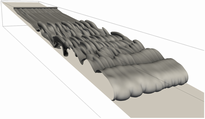** Progress in Earth and Planetary Science is the official journal of the Japan Geoscience Union, published in collaboration with its 51 society members.
** Progress in Earth and Planetary Science is partly financially supported by a Grant-in-Aid for Publication of Scientific Research Results to enhance dissemination of information of scientific research.
Gallery View of PEPS Articles
Research
Atmospheric and hydrospheric sciences
201711201711
High-resolution simulations of turbidity currents
Biegert E, Vowinckel B, Ouillon Rand, Meiburg E
Turbidity currents, Navier-Stokes simulations, Continuum formulation, Grain-resolving simulations
Concentration isosurface c = 0.25 at t = 10 (Re = 6000, vs = 0.005, N = 2.09, m = 0.0744). The iso-surface reveals the global structure of the envelope of a hyperpycnal current upon destabilization. The lobe-and-cleft instability is clearly visible at the head of the current as hills and crests form in the spanwise direction. This instability propagates in the body of the current and destabilizes the large 2D vortical structure initially present. The largest wavelength corresponds to the initial dominant mode of the instability and the width of the domain necessary to observe the instability at this given Reynolds number.
Pressure-driven flow over a dense sediment bed. The left figure shows an instantaneous slice through the domain, the color scale illustrating streamwise fluid velocity, and the gray scale illustrating particle velocity. The right figure shows the time-and-space-averaged streamwise velocity of the fluid and particles
We employ direct numerical simulations of the three-dimensional Navier-Stokes equations, based on a continuum formulation for the sediment concentration, to investigate the physics of turbidity currents in complex situations, such as when they interact with seafloor topography, submarine engineering infrastructure and stratified ambients. In order to obtain a more accurate representation of the dynamics of erosion and resuspension, we have furthermore developed a grain-resolving simulation approach for representing the flow in the high-concentration region near and within the sediment bed. In these simulations, the Navier-Stokes flow around each particle and within the pore spaces of the sediment bed is resolved by means of an immersed boundary method, with the particle-particle interactions being taken into account via a detailed collision model.







